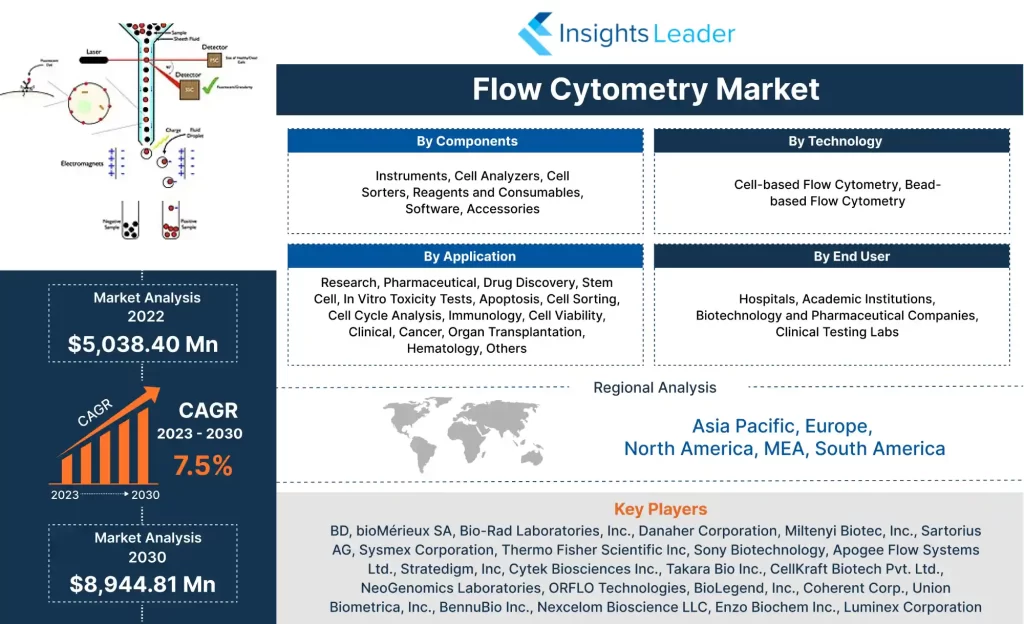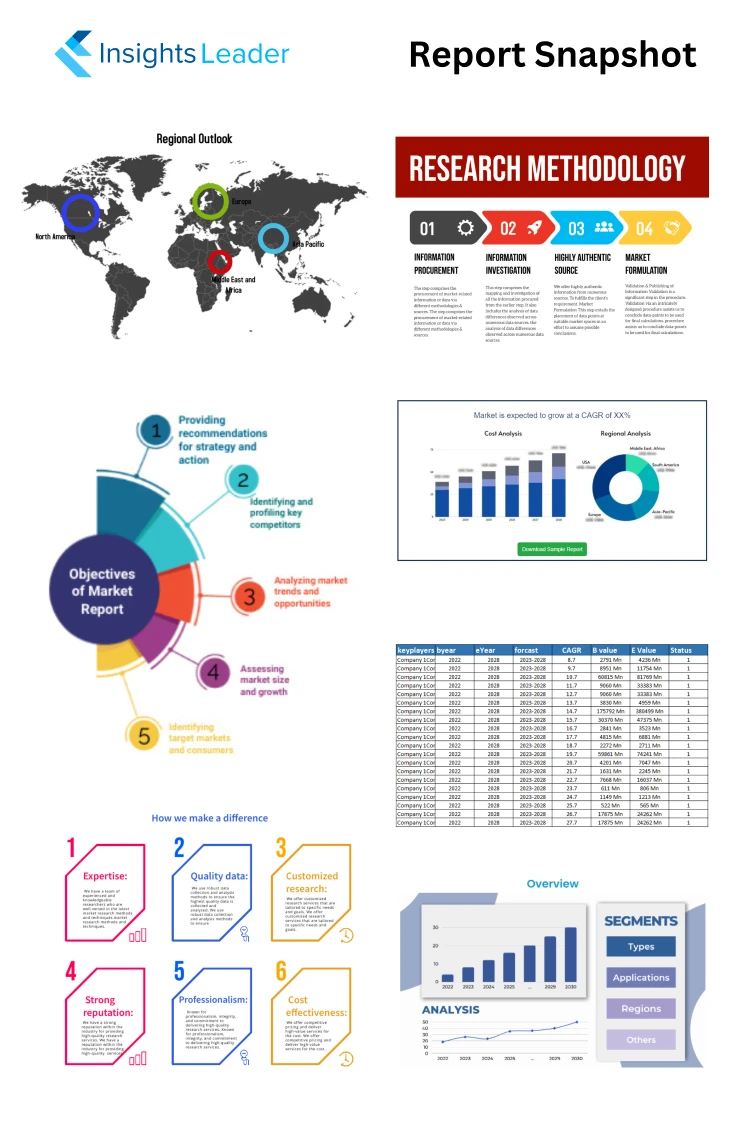Flow Cytometry Market Size 2024 to 2031
The major players in the flow cytometry market are substantially investing in the development of new product ranges related to flow cytometry instruments, reagents, and others with added features. The primary aim of the companies dealing in the flow cytometry market is to enable efficient characterization and count types of white blood cells in the evaluation of infectious diseases, autoimmune disorders, and immunodeficiencies. Thus, the technological advancements in flow cytometry are fostering market growth.
Report ID : IL_605 | Report Language's : En/Jp/Fr/De | Publisher : IL |
Format : 



Flow Cytometry Market Report Overview:
Flow cytometry is a technique used to detect and measure the physical and chemical characteristics of a population of cells or particles. In this process, a sample containing cells or particles is suspended in a fluid and injected into the flow cytometer instrument. The increasing adoption of flow cytometry in research applications is accelerating the growth of the market.
Flow Cytometry Market Size was valued at US$ 5,038.40 Mn in 2023, and is projected to reach US$ 8,944.81 Mn by 2031, growing at a CAGR of 7.5% from 2024 to 2031.
The Flow Cytometry market has witnessed remarkable growth in recent years, driven by technological advancements. This market research report provides a comprehensive analysis of the Flow Cytometry market, including current trends, key drivers and challenges, market segmentation, and a detailed forecast for the upcoming years. The report aims to assist industry stakeholders, investors, and decision-makers in understanding the market dynamics and formulating effective strategies for sustainable growth in this rapidly evolving sector.

Drivers
The major players in the flow cytometry market are substantially investing in the development of new product ranges related to flow cytometry instruments, reagents, and others with added features. The primary aim of the companies dealing in the flow cytometry market is to enable efficient characterization and count types of white blood cells in the evaluation of infectious diseases, autoimmune disorders, and immunodeficiencies. Thus, the technological advancements in flow cytometry are fostering market growth.
The Flow Cytometry market has experienced robust growth in recent years, and this trend is expected to continue in the foreseeable future.
The research report on the Flow Cytometry market utilizes a strategic market segmentation approach to gain a comprehensive overview of the industry. The segmentation is based on product type, application, end-user, and geographical region. By categorizing the market into distinct segments, such as different geographical regions, this report offers valuable insights into the market dynamics, customer preferences, and growth opportunities. The segmentation analysis enables businesses to identify target markets, tailor their strategies, and capitalize on emerging trends within the Flow Cytometry industry.
Overview of Key Industry Players
The Key Players section of a market research report offers a comprehensive introduction to the major companies operating in the market. This section provides valuable insights into the key players profiles, including their backgrounds, business overviews, and key highlights. It highlights the prominent market players who hold significant market shares and influence the industry dynamics.
The major players in the market are:
BD
bioMérieux SA
Bio-Rad Laboratories, Inc.
Danaher Corporation
Miltenyi Biotec, Inc.
Sartorius AG
Sysmex Corporation
Thermo Fisher Scientific Inc
Sony Biotechnology
Apogee Flow Systems Ltd.
Stratedigm, Inc
Cytek Biosciences Inc.
Takara Bio Inc.
CellKraft Biotech Pvt. Ltd.
NeoGenomics Laboratories
ORFLO Technologies
BioLegend, Inc.
Coherent Corp.
Union Biometrica, Inc.
BennuBio Inc.
Nexcelom Bioscience LLC
Enzo Biochem Inc.
Luminex Corporation
Market Trends Insights:
The Flow Cytometry market research report highlights several noteworthy market trends that are shaping the current business landscape. transformation continues to revolutionize the market. The widespread adoption of advanced technologies has transformed the way businesses operate, make policies, interact with customers, etc. These market trends are significantly influencing the strategies and decision-making processes of businesses across diverse sectors, presenting both challenges and opportunities for market players. this report consists in-depth analysis of current and upcoming future trends with all data.
By categorizing the market into segments:
By Components
Instruments
Cell Analyzers
Cell Sorters
Reagents and Consumables
Software
Accessories
By Technology
Cell-based Flow Cytometry
Bead-based Flow Cytometry
By Application
Research
Pharmaceutical
Drug Discovery
Stem Cell
In Vitro Toxicity Tests
Apoptosis
Cell Sorting
Cell Cycle Analysis
Immunology
Cell Viability
Clinical
Cancer
Organ Transplantation
Hematology
Others
By End User
Hospitals
Academic Institutions
Biotechnology and Pharmaceutical Companies
Clinical Testing Labs
Regional Analysis for Flow Cytometry Market:
North America (United States, Canada, and Mexico)
Europe (Germany, France, UK, Russia, and Italy)
Asia-Pacific (China, Japan, Korea, India, and Southeast Asia)
South America (Brazil, Argentina, Colombia, etc.)
Middle East and Africa (Saudi Arabia, UAE, Egypt, Nigeria, and South Africa)
The Flow Cytometry Market report includes a detailed regional analysis that provides a comprehensive understanding of market dynamics and trends across different geographic areas. The regional analysis focuses on key regions or countries, examining factors such as market size, market growth rate, market share, consumer behavior, and the competitive landscape within each region.
The regional analysis allows stakeholders to identify regional market potential and growth opportunities. It helps them understand the unique characteristics and preferences in different regions, this report also helps to target specific regional markets effectively. By recognizing regional variations in demand, purchasing power, and cultural nuances, stakeholders can make informed decisions about market entry, expansion, and resource allocation.
Additionally, the regional analysis provides insights into the competitive landscape within each region. It identifies major players, their market shares, and their strategies. This information helps stakeholders assess the competitive intensity and dynamics specific to each region, enabling them to develop competitive strategies that are tailored to the local market conditions.
Furthermore, the regional analysis highlights any regulatory, economic, or social factors that may impact the market within each region. It helps stakeholders understand the regional variations in regulatory frameworks, industry standards, and market entry barriers. This knowledge allows stakeholders to navigate the regional landscape effectively, adapt their business practices, and comply with local regulations.
By addressing these key questions, this market research report provides valuable insights and actionable information to make informed decisions, develop effective strategies, and navigate the market successfully.
This report offers key benefits for stakeholders:
1) Informed Decision-Making:
Flow Cytometry Market research reports provide stakeholders with comprehensive and accurate information about the market, including industry trends, competitor analysis, customer preferences, and market dynamics. This enables stakeholders to make well-informed decisions based on reliable data and insights, reducing the risk of making costly mistakes.
2) Market Opportunities:
By analyzing this report, stakeholders can identify emerging trends, niche markets, and untapped opportunities. These reports provide valuable information on consumer demands, market gaps, and potential areas for growth, allowing stakeholders to develop strategies to capitalize on these opportunities and gain a competitive edge.
3) Risk Mitigation:
This research report helps stakeholders to assess market risks and potential challenges. By understanding the market landscape, including competitor strategies, regulatory changes, and economic factors, stakeholders can proactively identify and mitigate potential risks. This enables them to adapt their business plans, develop contingency measures, and minimize the impact of unforeseen events.
4) Customer Insights:
Flow Cytometry Market reports provide valuable insights into customer behavior, preferences, and needs. By understanding their target audience better, stakeholders can tailor their products, services, and marketing strategies to meet customer expectations effectively. This enhances customer satisfaction, fosters brand loyalty, and drives business growth.
5) Competitive Advantage:
Accessing market research reports gives stakeholders a competitive advantage by understanding the strengths and weaknesses of their competitors. These reports provide valuable information on market share, product offerings, pricing strategies, and customer perception. Armed with this knowledge, stakeholders can develop strategies to differentiate themselves, improve their products or services, and effectively position themselves in the market.
6) Long-term Planning:
Market research reports help stakeholders in long-term planning and forecasting. By analyzing historical data, market trends, and future projections, stakeholders can make informed decisions regarding investment, expansion, product development, and market entry strategies. This enables them to align their business goals with market realities and plan for sustainable growth.
Overall, the Flow Cytometry Market research reports empower stakeholders with valuable insights and data-driven information, enabling them to make informed decisions, identify market opportunities, mitigate risks, and gain a competitive edge in the ever-evolving business landscape.
Key questions answered by this Flow Cytometry Market Research Report:
1) What is the current size and projected growth of the market?
2) What are the market trends and dynamics influencing the industry?
3) Who are the major competitors in the Flow Cytometry market and what are their market shares?
4) What are the key customer segments and their preferences?
5) What are the drivers and barriers to market growth?
6) What are the emerging market opportunities and potential risks?
7) What are the pricing trends and strategies in the market?
8) What are the regulatory and legal considerations impacting the industry?
9) What are the technological advancements shaping the Flow Cytometry market?
10) What are the key marketing and distribution channels used in the industry?
Note: Our services encompass tailor-made reports that cater to our customers specific needs. Additionally, we grant customization options for reports at both regional and country levels. To ensure utmost accuracy in market forecasting, each report is diligently updated before delivery, meticulously considering the global and regional impacts of COVID-19, as well as the Russia-Ukraine crises.
